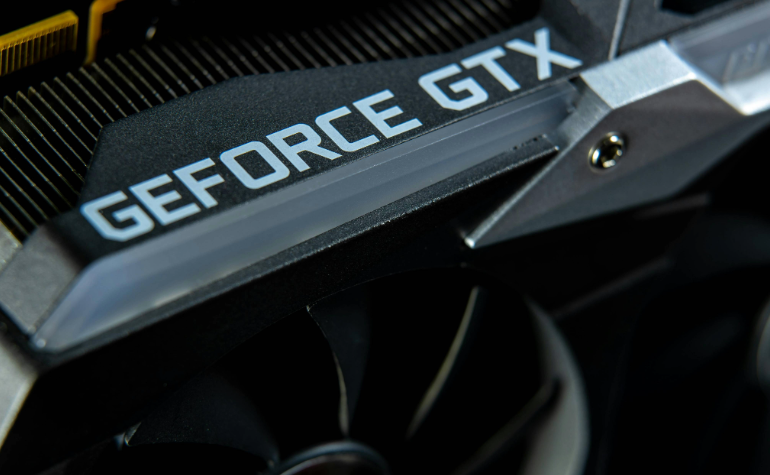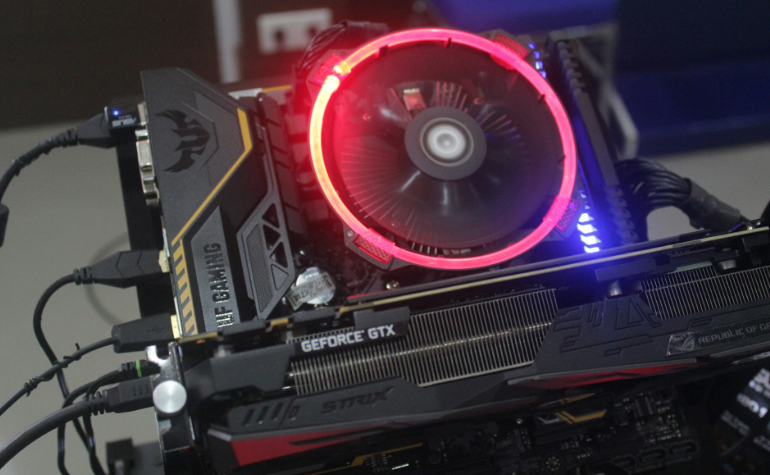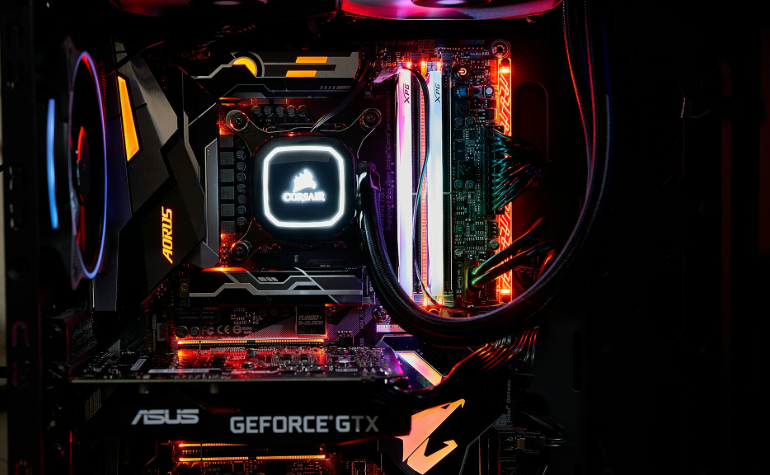PAX East: NVIDIA's Bryan Del Rizzo on GTX 400 Series
Exclusive PAX East interview with NVIDIA's Bryan Del Rizzo. Get insights on the groundbreaking GTX 400 series GPUs.

Welcome to our exclusive feature from PAX East, where we sat down with NVIDIA's Bryan Del Rizzo to dive deep into the intricacies and innovations of the GTX 400 series. As NVIDIA continues to push the boundaries of gaming technology, this interview offers an inside look at the developments and the driving forces behind their latest GPU series. Whether you're a tech enthusiast or a hardcore gamer, understanding the impact of these advancements can enhance your appreciation of what goes into powering your gameplay.
Bryan Del Rizzo is a well-recognized figure in the tech industry, known for his expertise and contributions to NVIDIA, a titan in the world of graphics processing. NVIDIA, a company that has been at the forefront of graphical innovations, has consistently delivered solutions that not only enhance the visual experience but also improve overall performance. This discussion with Del Rizzo not only sheds light on the technical prowess of the GTX 400 series but also highlights the company’s vision and commitment to leading the charge in next-generation gaming technologies.

The Evolution of the GTX 400 Series
The GTX 400 series represents a significant leap forward in NVIDIA's lineup of graphics cards, marking a pivotal moment in the evolution of gaming and rendering technologies. This series introduced new capabilities aimed at providing superior performance and enhanced graphical fidelity, setting a new benchmark for what gamers and professional creators can expect from their hardware. By exploring the development and impact of the GTX 400 series, we gain insight into how NVIDIA has shaped the future of visual computing.
Key Features of the GTX 400 Series
- CUDA Cores: Increased number of CUDA cores for better parallel processing capabilities, enabling more complex computations and richer graphical details.
- Ray Tracing: Introduction of hardware-accelerated ray tracing for realistic lighting and reflections, a feature that later becomes standard in future generations.
- Power Efficiency: Improved power management technologies to balance performance with energy consumption, making the GTX 400 series not only powerful but also more efficient.
- Enhanced Thermal Design: Innovations in cooling solutions to handle increased power demands while maintaining lower temperatures during peak loads.
Advances from Previous GPU Generations
- Graphics Architecture: Transition to a new architecture that offers significantly higher processing power and efficiency compared to previous models.
- Memory Bandwidth: Enhanced memory bandwidth to support higher resolutions and faster frame rates, crucial for the latest games and professional applications.
- Shader Performance: Improved shader performance for better rendering of complex visual effects and more dynamic scenes.
- Software Support: Robust driver and software updates that optimize performance, compatibility, and stability across a wide range of applications and games.
The GTX 400 series not only set new standards in the industry but also demonstrated NVIDIA's commitment to pushing the boundaries of what gaming technology can achieve. Through a blend of innovative hardware design and strategic software enhancements, the GTX 400 series has paved the way for future generations of GPUs, offering users unprecedented levels of performance and realism in their gaming and creative endeavors. This evolution is not just about technical achievements but also about setting the stage for the future of digital entertainment and content creation.
Challenges in Developing the GTX 400 Series
Developing the GTX 400 series was a monumental task that presented numerous challenges for NVIDIA's engineering team. From managing technical complexities to navigating production hurdles, the journey to bring the GTX 400 series to market was fraught with difficulties that tested the limits of existing technologies and manufacturing processes. This section delves into the specific challenges encountered during the development of this groundbreaking series and the innovative solutions that were implemented to overcome them.
Technical Challenges Faced
- Heat Dissipation: Managing the substantial heat generated by the increased processing power was a significant challenge. Developing efficient cooling solutions was paramount to ensure stable performance under load.
- Power Consumption: Balancing the high-performance capabilities with reasonable power consumption levels required innovative approaches to circuit design and power management.
- Silicon Yields: Achieving acceptable yields with new semiconductor technologies involved overcoming issues related to the complexity and size of the new chips, which were prone to defects during initial production runs.
Overcoming Production Issues
- Refining Manufacturing Processes: NVIDIA worked closely with fabrication plants to refine the production process, improving the yield rates and quality of the final GPU chips.
- Supply Chain Management: Streamlining the supply chain to handle the demand and complexities of new materials and components was crucial to ramp up production without compromising quality.
- Collaboration with Partners: Strengthening partnerships with third-party manufacturers and suppliers helped to mitigate risks associated with the cutting-edge technologies used in the GTX 400 series.
The path to releasing the GTX 400 series was a testament to NVIDIA's commitment to innovation and excellence. Despite the formidable challenges, the team's ability to adapt and innovate not only led to the successful launch of the GTX 400 series but also significantly advanced the field of graphics processing technology. This relentless pursuit of breakthroughs has solidified NVIDIA's reputation as a leader in the GPU industry, ready to tackle the next generation of challenges in the evolving world of computing.

Performance Benchmarks
The GTX 400 series set new performance benchmarks that not only highlighted its capabilities but also positioned it as a formidable contender in the competitive GPU market. This section explores how the GTX 400 series stacks up against its competitors and evaluates its performance in real-world gaming scenarios, providing a clear picture of what gamers and professionals can expect from this innovative series.
Comparison with Competitors
- Higher Core Counts: Compared to its main rivals, the GTX 400 series offers more CUDA cores, leading to better parallel processing and improved handling of complex graphics tasks.
- Advanced Ray Tracing Capabilities: While competitors were just starting to explore ray tracing, the GTX 400 series integrated it more deeply, offering superior realism in lighting and shadows.
- Faster Memory Speeds: The series features higher memory speeds, which translates to quicker data processing and smoother performance in high-resolution settings.
Real-World Gaming Performance
- Enhanced Frame Rates: Gamers can enjoy significantly higher frame rates in most modern games, even at higher resolutions, providing a smoother and more immersive gaming experience.
- Reduced Latency: Optimizations in the GTX 400 series reduce latency, crucial for competitive gaming where every millisecond counts.
- Improved Graphics Fidelity: With the introduction of new technologies in the GTX 400 series, games not only run smoother but also look more detailed and vibrant.
The GTX 400 series has proven itself as a powerful upgrade over its predecessors, setting high standards in both technical specifications and actual performance outputs. The enhancements brought by this series have not just kept pace with industry expectations but have often surpassed them, offering users a compelling reason to choose NVIDIA for their high-performance computing needs. These advancements ensure that the GTX 400 series remains a preferred choice for gamers and creative professionals looking for top-tier graphics processing capabilities.
Future of Gaming Technology at NVIDIA
Exploring the future of gaming technology at NVIDIA provides a glimpse into the exciting advancements that lie ahead. In this section, we discuss insights from Bryan Del Rizzo, a key figure at NVIDIA, and examine the expected trends in GPU technology that are likely to shape the next generation of gaming and professional graphics.
Insights from Bryan Del Rizzo
- Continued Innovation in Ray Tracing: Del Rizzo emphasizes NVIDIA's commitment to pushing the boundaries of ray tracing technology, promising even more realistic and immersive gaming experiences.
- AI Integration: He highlights the increasing role of AI in gaming, from improving game design to enhancing in-game graphics dynamically.
- Sustainability Efforts: Del Rizzo mentions NVIDIA's ongoing efforts to increase the energy efficiency of their GPUs, aligning with broader environmental goals.
Expected Trends in GPU Technology
- Greater Emphasis on AI Capabilities: Future GPUs are expected to integrate more advanced AI algorithms to handle complex computations more efficiently.
- Hybrid Rendering Techniques: A shift towards combining rasterization and ray tracing to balance performance and visual fidelity.
- Expansion into Cloud Gaming: NVIDIA is set to enhance its cloud gaming platforms, making high-end gaming more accessible to a broader audience.
The trajectory that NVIDIA is charting for the future of gaming technology not only reflects their leadership in the GPU market but also their vision to continually redefine what is possible in digital entertainment. With each innovation, NVIDIA seems poised to offer more powerful, more immersive, and more accessible gaming experiences. This commitment to innovation secures their place at the forefront of technology, driving the industry forward and influencing how games are played and experienced around the world.

Implications for Gamers and Developers
The launch of the GTX 400 series by NVIDIA has significant implications not only for gamers who crave the latest in high-performance gaming hardware but also for developers who push the limits of what's possible in game design. This section explores how the capabilities of the GTX 400 series influence game development and the tangible benefits they bring to the gaming community.
What This Means for Game Development
- Enhanced Graphics Capabilities: Developers can harness the GTX 400 series to create more detailed and visually stunning game environments.
- Increased Processing Power: The improved processing power allows for more complex simulations and AI behaviors, making games more dynamic and engaging.
- Broader Creative Possibilities: With advanced technologies such as ray tracing, developers can achieve more realistic lighting and shadows, offering gamers an immersive experience like never before.
Advantages for Gamers
- Superior Gaming Experience: Gamers enjoy richer, more complex worlds with lifelike graphics and smoother gameplay due to the GTX 400 series’ enhanced capabilities.
- Future-Proofing: Investing in a GTX 400 series GPU means staying ahead of the curve in terms of compatibility with upcoming game releases that utilize high-end graphics technologies.
- Enhanced VR and AR Experiences: The power of the GTX 400 series improves the performance and realism of virtual and augmented reality games, providing a more immersive experience.
With the introduction of the GTX 400 series, NVIDIA not only sets a new standard for graphical performance but also reshapes the gaming landscape. Developers are given the tools to innovate and elevate the gaming experience, while gamers benefit from the heightened realism and immersive gameplay. This symbiotic relationship between hardware capability and software creativity continues to drive the gaming industry forward, promising an exciting future for all involved.
Closing Thoughts
As our in-depth discussion with Bryan Del Rizzo at PAX East concludes, it's clear that NVIDIA's GTX 400 series is not just another step in GPU technology but a giant leap forward for the entire gaming and development community. This final section recaps the crucial insights gained from our interview and explores the future implications and expectations set forth by NVIDIA's ongoing innovations.
Summary of Key Points from the Interview
- Innovative Features: Del Rizzo emphasized the GTX 400 series’ advancements in ray tracing, AI integration, and energy efficiency.
- Challenges Overcome: The development journey involved significant hurdles in thermal management, power efficiency, and manufacturing processes, all of which were successfully navigated.
- Impact on Gaming and Development: The series has set new benchmarks in performance, opening up new possibilities for game developers and offering gamers unprecedented gaming experiences.
Future Expectations and Conclusions
- Continued Leadership in Innovation: NVIDIA is expected to continue leading the charge in graphics processing technology, with ongoing enhancements to GPU capabilities.
- Expansion into New Realms: The GTX 400 series lays the groundwork for further explorations into AI and machine learning applications within gaming.
- Long-Term Impact on the Industry: The technological advancements introduced by the GTX 400 series are likely to influence gaming trends and developer strategies for years to come.
The discussion with Bryan Del Rizzo has been illuminating, providing not only a look back at the monumental effort involved in bringing the GTX 400 series to fruition but also a forward glance at what these developments mean for the future. As NVIDIA continues to innovate, the ripple effects of these advancements will undoubtedly shape the contours of gaming technology, ensuring that gamers and developers alike can look forward to more immersive, more beautiful, and more complex gaming experiences. This ongoing evolution is a testament to NVIDIA's role as a pioneer and leader in the world of digital entertainment and graphical performance.
Additional Resources
For those intrigued by the capabilities and the future of the GTX 400 series as discussed in our interview with Bryan Del Rizzo, there are several resources available to deepen your understanding and keep abreast of the latest developments from NVIDIA. This section provides links for further reading and advice on how to stay updated with the latest announcements from NVIDIA, ensuring that enthusiasts and professionals alike have the information they need to make informed decisions and stay at the cutting edge of technology.
Links to further reading
- Official NVIDIA Blog: Visit NVIDIA’s official blog for detailed articles on their technology advancements and detailed breakdowns of GPU functionalities.
- Tech Review Sites: Websites like TechRadar, CNET, and AnandTech offer in-depth reviews, performance benchmarks, and comparisons of the GTX 400 series.
- Academic Journals: For those interested in the technical underpinnings, journals in computer science and electronics often publish papers on GPU technology and its applications.
How to stay updated with NVIDIA announcements
- NVIDIA Newsroom: Subscribe to the NVIDIA newsroom for press releases and official updates directly from the company.
- Social Media: Follow NVIDIA on platforms like Twitter, Facebook, and LinkedIn where they frequently post updates and interact with the community.
- Email Newsletters: Sign up for NVIDIA’s email newsletters to receive news, product updates, and special offers in your inbox.
As NVIDIA continues to push the boundaries of what's possible in graphics technology, staying informed through these resources will help enthusiasts and developers alike understand and leverage the full potential of the GTX 400 series and beyond. Whether it's through reading detailed analyses, engaging with content directly from NVIDIA, or following real-time updates, there's a wealth of information available that can enhance both knowledge and application of these technological advances.
Popular Articles
Cooler Master H612PWM Review: Top Performance & Quiet
Corsair Dominator Platinum: High-Performance RAM
Revolutionizing CPU HSF Testing: New Techniques & Insights
Thermaltake Element V Black Edition Review: Ultimate Performance





